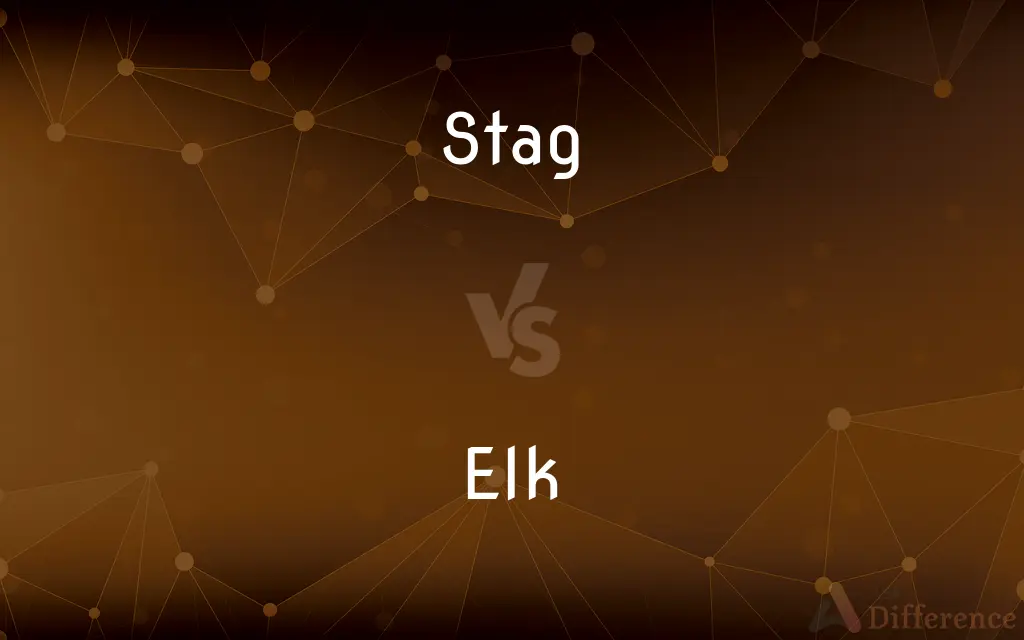Stag vs. Elk — What's the Difference?
By Maham Liaqat & Urooj Arif — Updated on April 16, 2024
A stag generally refers to any male deer, while an elk is a specific species of large deer found primarily in North America and parts of Asia.

Difference Between Stag and Elk
Table of Contents
ADVERTISEMENT
Key Differences
The term stag is broadly used to describe male deer of any species, emphasizing its gender and maturity. On the other hand, an elk is a distinct species within the deer family, known scientifically as Cervus canadensis, characterized by its larger size and distinctive antlers. Both terms refer to members of the deer family, but elk specifically refers to one of the largest deer species.
Stags are known for their role in mating rituals, where they often compete for the attention of females through displays of strength and their impressive antlers. Whereas elk are not only recognized for similar behaviors but are also noted for their unique vocalizations during the rut, known as bugling, which is a loud series of vocal sounds used to attract mates and assert dominance.
In terms of habitat, stags, depending on their species, can be found in various environments ranging from European woodlands to Asian and North American forests. Elk, however, primarily inhabit the forests and forest edges of North America and eastern Asia, adapting well to cold climates and mountainous terrain.
The hunting and cultural significance of these animals also differ. Stags, across various cultures, symbolize virility and forest lore, often featured in heraldry and literature. In contrast, elk hold a particular place in North American wildlife management and conservation efforts, being a major target for game hunting and a subject of ecological studies due to their impact on their habitats.
While the term stag can apply to many different species, making it more generic, elk refers specifically to a species that is larger and generally more specialized in terms of behavior and habitat requirements, often celebrated for its size and the majesty of its antlers.
ADVERTISEMENT
Comparison Chart
Definition
Male deer of any species
A large species of deer (Cervus canadensis)
Species Variability
Refers to many species
Refers specifically to one species
Habitat
Varied, depends on species
Forests and forest edges in North America and Asia
Antler Characteristics
Generally smaller compared to elk
Large and more branched antlers
Cultural Significance
Featured in various myths and heraldry
Important in North American wildlife management
Compare with Definitions
Stag
A male deer.
The stag raised its head alertly at the sound of footsteps.
Elk
A large species of deer known for its impressive antlers.
An elk was spotted grazing in the meadow at dusk.
Stag
Symbolic in many cultures, representing strength and fertility.
The ancient tapestry depicted a majestic stag in the forest.
Elk
Involved in ecological studies due to their habitat impacts.
Researchers study elk to understand forest regeneration.
Stag
Used specifically to describe a male deer used for breeding.
The dominant stag often battles others during the mating season.
Elk
Known for their distinctive bugling during the rut.
The sound of the elk bugling echoed through the valley.
Stag
In British English, also refers to a man celebrating his upcoming marriage.
They threw a stag party for him the night before his wedding.
Elk
A popular game animal in North American hunting.
Hunting elk requires a special permit in most states.
Stag
Used in various expressions and stories across cultures.
The folklore often features a wise stag who helps lost travelers.
Elk
Primarily found in North America and parts of Asia.
Elk populations thrive in the national parks of the Rocky Mountains.
Stag
A person who attends a social gathering unaccompanied by a partner, especially a man who is unaccompanied by a woman.
Elk
The elk (Cervus canadensis), also known as the wapiti, is one of the largest species within the deer family, Cervidae, and one of the largest terrestrial mammals in North America, as well as Central and East Asia. It is often confused with the larger Alces alces, which is called moose in North America, but called elk in British English, and related names in other European languages (German Elch, Swedish älg, French élan).
Stag
A social gathering for men only.
Elk
A large reddish-brown or grayish deer (Cervus canadensis) of western North America, having long, branching antlers in the male. The elk is sometimes considered a subspecies of the closely related red deer. Also called wapiti.
Stag
Of or for men only
A stag party.
Elk
Chiefly British The moose.
Stag
Pornographic
Stag films.
Elk
A light, pliant leather of horsehide or calfskin, tanned and finished to resemble elk hide.
Stag
Unaccompanied
Went to the dance stag.
Elk
Any of various large species of deer such as the red deer, moose or wapiti (see usage notes).
Stag
To attend a social gathering unaccompanied by a partner. Used especially of men.
Elk
Any of the subspecies of the moose (Alces alces, alternatively named Eurasian elk to avoid confusion with the wapiti), that occurs only in Europe and Asia.
Stag
(countable) A colt, or filly.
Elk
Any moose (Alces alces), the largest member of the deer family.
Stag
A romping girl; a tomboy.
Elk
(North America) common wapiti (Cervus canadensis), the second largest member of the deer family, once thought to be a subspecies of red deer.
Stag
(countable) An improperly or late castrated bull or ram – also called a bull seg (see note under ox).
Elk
(British India) Sambar (Cervus unicolor).
Stag
An outside irregular dealer in stocks, who is not a member of the exchange.
Elk
A large deer, of several species. The European elk Alces alces (formerly Alces machlis or Cervus alces) is closely allied to the American moose. The American elk, or wapiti (Cervus Canadensis) the largest member of the deer family, has large, spreading antlers and is closely related to the European stag. See Moose, and Wapiti.
Stag
One who applies for the allotment of shares in new projects, with a view to sell immediately at a premium, and not to hold the stock.
Elk
The European wild or whistling swan (Cygnus ferus).
Stag
An unmarried man; a bachelor; a man not accompanying a woman at a social event.
A stag dance; a stag party; a stag bar
Elk
A member of the fraternal organization named Benevolent and Protective Order of Elks, supporting various services to their communities.
Stag
(countable) A social event for men held in honor of a groom on the eve of his wedding, attended by male friends of the groom; sometimes a fundraiser.
The stag will be held in the hotel's ballroom.
Elk
Large northern deer with enormous flattened antlers in the male; called elk in Europe and moose in North America
Stag
Guard duty.
Stag
(countable) A stag beetle (family Lucanidae).
Stag
(countable) The Eurasian wren, Troglodytes troglodytes.
Stag
To act as a "stag", an irregular dealer in stocks.
Stag
(transitive) To watch; to dog, or keep track of.
Stag
Of a man, attending a formal social function without a date.
My brother went stag to prom because he couldn't find a date.
Stag
A colt, or filly; also, a romping girl.
Stag
A castrated bull; - called also bull stag, and bull seg. See the Note under Ox.
Stag
An outside irregular dealer in stocks, who is not a member of the exchange.
Stag
The European wren.
Stag
To act as a "stag," or irregular dealer in stocks.
Stag
To watch; to dog, or keep track of.
Stag
Male red deer
Stag
Attend a dance or a party without a female companion
Stag
Give away information about somebody;
He told on his classmate who had cheated on the exam
Stag
Watch, observe, or inquire secretly
Common Curiosities
What is the primary difference between a stag and an elk?
A stag refers to any adult male deer, while an elk is a specific species known for its size and antler structure.
How big can an elk get?
Elk can weigh up to 700 pounds and stand up to 5 feet at the shoulder.
What is a stag?
A stag is an adult male deer of any species.
Can the term stag be used interchangeably with elk?
Not accurately, as stag is a general term and elk specifies a particular species.
Are elk antlers different from those of other stags?
Yes, they tend to be larger and have more branches.
Are all male deer called stags?
In many cultures, yes, though specific terms like "buck" are also used in North America.
Why are elk important in wildlife management?
Due to their size, habitat needs, and the impact they have on their environments, they are crucial for ecological studies and conservation efforts.
Is there a specific hunting season for elk?
Yes, it varies by region but generally falls within the autumn months.
Do stags and elk have different conservation statuses?
Yes, depending on the specific deer species categorized as stags and the regional populations of elk, their conservation statuses can vary.
What is unique about elk antlers?
Elk antlers are larger and more complexly branched than those of most other deer species.
Where are elk found?
Elk are native to North America and eastern parts of Asia.
How do stags and elk behave during mating season?
Both engage in displays of strength and antler battles to attract females and establish dominance, but elk are also known for their loud bugling.
What cultural significance do stags have?
Stags are often symbolic of strength, virility, and forest lore in various cultures around the world.
What roles do elk play in their ecosystems?
Elk affect vegetation and prey-predator dynamics, making them key species in their habitats.
Can elk be found in urban areas?
Rarely, as they prefer forested areas and grasslands away from urban development.
Share Your Discovery

Previous Comparison
Reap vs. Harvest
Next Comparison
Dragon vs. GriffinAuthor Spotlight
Written by
Maham LiaqatCo-written by
Urooj ArifUrooj is a skilled content writer at Ask Difference, known for her exceptional ability to simplify complex topics into engaging and informative content. With a passion for research and a flair for clear, concise writing, she consistently delivers articles that resonate with our diverse audience.














































